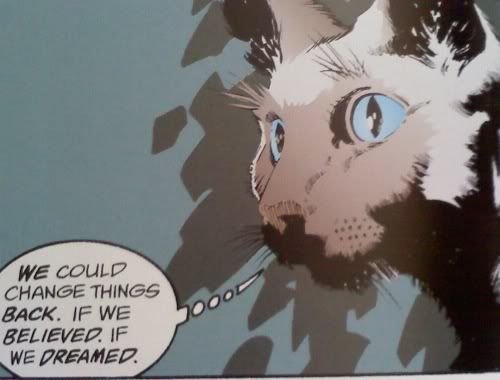
This story leaves more space than any other in the series for readers to project their own interpretation of exactly what happens in the story.
First, how you feel about cats can alter the entire tone of the story. For instance, Linda Holmes at NPR enjoys the story from the angle of "kittens are so adorable! How sweet it is when they try to be devious and political!"
I read the story as secret access to the minds of housecats; I truly believe that 99% of cats spend their time thinking about revolting against their owners, but generally err on the side of laziness.
The other open question is whether the entire story is even real. Did cats once rule the humans, or is it all just a dream? Can Morpheus be a kingmaker in reality, or just in dreams? I'm not gonna answer this question for you, but I believe it will be addressed later in the series.
ON THE VERY NATURE OF STORIES
I find myself searching for an Orwellian connection but I struggle to find one. The cat's political prowess is nowhere near the level of the pigs in Animal Farm, nowhere near as eloquent as the government in 1984. And yet, I cannot believe it does not relate somehow. After all, the entire Sandman series is grounded in archetypal stories, fables and myths, and I think "Dream Country" is even more so -- the stories address, respectively, Calliope, Aesop's Fables or Animal Farm?, Shakespeare, and Superheroes.
"1000 Cats" doesn't really fit into the Aesop's Fables mold though, as there is no overarching moral lesson to be gleaned from the story (except maybe "don't kill the kittens!"). So while the other three stories have clear intellectual forebears, placing those myths into the Sandman Universe, I'm not sure what myth this story is exploiting.
Maybe it's a political allegory, a critique of Marxism/Communism perhaps. Like those movements, this revolution rests on a cult of personality, without which the hoi polloi have no impetus to act (of course in this case, it's still not enough for them to act, even in dreams).
Maybe it's a racial allegory, showing how the "purebred Siamese" has delusions of grandeur, of leadership, or superiority. Which would tie into a religious, manifest destiny point: he goes from country to country, converting the heathens, trying to falsely empower them with the concept of Cat Supremacy.
CONCLUSION, IN SO FAR AS SUCH ANALYSES CAN BE CONCLUDED
While Gaiman asks us to empathize with the cat and demonize the humans who murdered its children, I believe he does so as a satire of the emotional exploitation that is part and parcel of political communication (DING DING ORWELL CONNECTION FOUND). For while we listen to the cat's cheap emotional appeals, do we ever stop to think what sort of rulers the cats would be? We are shown what sorts of rulers they once were, even more savage than the humans. Even for the cats, their lives are less savage and more comfortable than before.
Then again, maybe it's all just a story, and nothing more.


Pretty sure that this particular story has it's roots firmly embedded in the Dreamlands of two long dead writers.....Lord Dunsany and H.P.Lovecraft....
ReplyDeleteparticularly the short stories Idle days on the Yann & The Shop on Go-By Street by Dunsany and The Cats of Ulthar & Dream Quest of Unknown Kadath by lovecraft...
lovecraft himself was deliberately borrowing the Dreamland of Dunsany for these particular stories
The Doll's House arc began with a tale that men tell other men, and reminded us at the end that the women of the tribe tell it rather differently. This is Gaiman's idea of a story that cats might tell to other cats. I understand one of the inspirations was Fritz Leiber's 'Space-Time for Springers', another great funny-sad story about a cat with big dreams.
ReplyDeleteI do think the sadness is stronger than the humour though. When it's sharp it's very sharp indeed; Hayley Campbell credits the panel of the drowning kittens with destroying her faith in the goodness of mankind. And a more sentimental writer might make the world of the cat-kings a sweet and charming place; Gaiman reminds us that a cat's idea of paradise is a pretty cruel and savage thing.
There are some lovely touches here - the unusual tails for the thought/word balloons, and the way we never see human faces. I particularly like the siamese declaiming from the angel's head. You have the human as underdog (undercat?) as well the symbolic value of the angel as a messenger. There is also something spooky and comical in the angel's expression. It's as if the human figure is turned away or frozen in time, ignorant of the other reality under their feet.
For my part, I don't read the story allegorically. It would be too restrictive. If it has a central thesis it's that dreams can shape the real world, and not only as viral ideas. Consensual reality runs all the way through the Sandman mythos; it's not only the gods that are generated by belief.
And to quote Terry Pratchett in "The Unadulterated Cat" :
ReplyDelete"Cats have a way of always having been there even if they've only just arrived. They move in their own personal time. They act as if the human world is one they just happened to have stopped off in, on their way to somewhere that is possibly a whole lot more interesting."